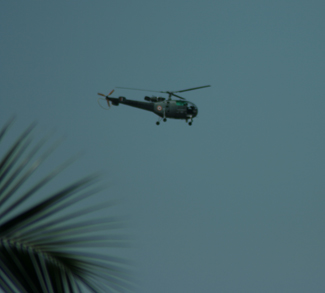Nuclear deterrence is existential. States will have myriad ways to strengthen their nuclear deterrence: through land-based, aerial based, and sea-based nuclear weapons delivery mechanisms. Irrespective of the delivery platforms, nuclear signaling is crucial to nuclear deterrence. There is limited relevance of nuclear weapons unless a strong signaling is achieved. Such signaling could be both strategically and politically relevant. In 2015, when Iran developed its nuclear capable long range cruise missile, the Soumar, the missile had political and strategic signaling strings attached to it.
In September 2024, India successfully test-fired the intermediate range Agni-IV nuclear-capable ballistic missile. The success of the missile test signaled many parameters of nuclear deterrence. The missile was operationally ready while its technical parameters were also validated through the successful test. Operational readiness of nuclear delivery systems is another key factor that determines nuclear deterrence.
Mere possession of nuclear delivery systems is not enough: they need to be operationally prepared for quick response. Frequent testing of missile systems is one way to ensure operational readiness by validating relevant technological parameters that would enable the missile to not just take off during crisis situation but also be able to deliver the payload to assigned target, thus ensuring reliability. This can be ensured when missiles meet all trial objectives during their flight tests.
Considering that the missile is capable of striking ranges of up to 4000 km, potentially reaching many parts of mainland China, the Agni-IV missile imposes nuclear security challenges for China. The missile is also dual capable, that is capable of carrying both nuclear and conventional warheads, similar to China’s DF-21 ballistic missile series. Dual capable missiles complicate ‘balance of terror’ in nuclear deterrence, as adversaries could be in dilemma about the warhead type of the missile during crisis situation. It also makes survivability of India’s Agni-IV missiles stronger during the crisis phase when the missile is deployed.
Again, as India is exposed to a two-pronged war with China and Pakistan, such long-range capabilities allow for the launching of nuclear weapons against Pakistan from any region. Though other shorter range Agni series exist in India’s nuclear arsenal as deterrence against Pakistan, such long-range missile capabilities that could reach Pakistani territories from any part of India further increases the stakes for Pakistan to launch even its tactical nuclear weapons (TNWs). These capabilities close the scope for a ‘flexible response’ from Pakistan as longer range nuclear capable missiles could be launched from any part of the territory as a response to TNWs.
One mode of survivability of nuclear capable missiles is dispersal. Hence, having dual capable nuclear missiles with some of them being conventionally armed, while other systems with nuclear warheads, dispersed in various locations, raises the risk factor for adversaries seeking to destroy such capabilities.
India does distinguish between ‘induction’ and ‘deployment’ of its nuclear forces. ‘Induction’ is a peace time procedure to strengthen nuclear deterrence while ‘deployment’ is a crisis time procedure to strengthen deterrence. In 2023, the Agni-IV missile underwent successful testing for pre-induction night launch.
The road mobility of a missile system strengthens survivability and possessing a mobile land-based nuclear deterrence mechanism reduces the burden on India’s sea-based nuclear deterrence. This fact echoes debates in the United States over developing a mobile intercontinental ballistic missile (ICBM) capacity.
‘Credible minimum deterrence’ is key feature of India’s nuclear deterrence. This means that India does not aim to possess quantitatively large nuclear arsenals. Instead, it aims to develop qualitative nuclear arsenals that are able to survive enemy first strikes and can be launched against adversaries’ targets in a crisis situation. Qualitative improvements in missile systems include making them mobile, equipping them with countermeasures against missile defense systems, and improving their accuracy and performance.
In fact, strategic deterrence is strengthened when a state has developed assets that can dissuade adversaries from launching an attack in the first place. Concepts such as ensuring reliability, safety, security, and readiness are key to US nuclear deterrence. The same principles, given the necessary advancements in technology, can ensure the readiness, reliability, safety, and security needed to strengthen India’s ‘credible minimum deterrence,’ which will further solidify the country’s ‘no-first use’ doctrine, keeping the nuclear threshold relatively high and improving strategic deterrence.
However, these parameters of reliability, safety, security, and readiness can only be measured when missiles undergo frequent testing. Failures in flight tests result in correction in technological parameters. Such successful technological parameters can be applied to other missile systems as well. For instance, the Agni-IV itself is an upgraded version of Agni-II Prime, with an enlarged first-stage motor, upgraded second-stage motor, improved guidance and electronics, and new thrust vector control systems that maintain the orientation of the missile during its flight.
Another technical improvement has been the use of maraging steel and carbon fiber in the missile casing, improving overall reliability. Maraging steel provides a high strength-to-weight ratio, enabling a missile structure that is as light as possible. Such metallic materials also provide high fracture toughness to ensure that the missile remains intact during flight stages. Nonmetallic materials like carbon fiber ensures thermal stability, high thermal conductivity and low thermal expansion, retention of mechanical strength, and maintenance of good frictional properties over different temperature ranges. Since the missile contains solid propellant, a composite rocket motor enhances the missile performance even when the missile system is mobile.
In sum, a credible nuclear deterrence implies that missiles do not face technological limitations impacting their functionality during flight tests. This means that delivery systems must be technologically advanced to survive enemy missile attacks, enemy missile defense, along with other external factors like weather conditions and technical glitches. This is the context in which the recent Agni-IV missile tests should be viewed.




